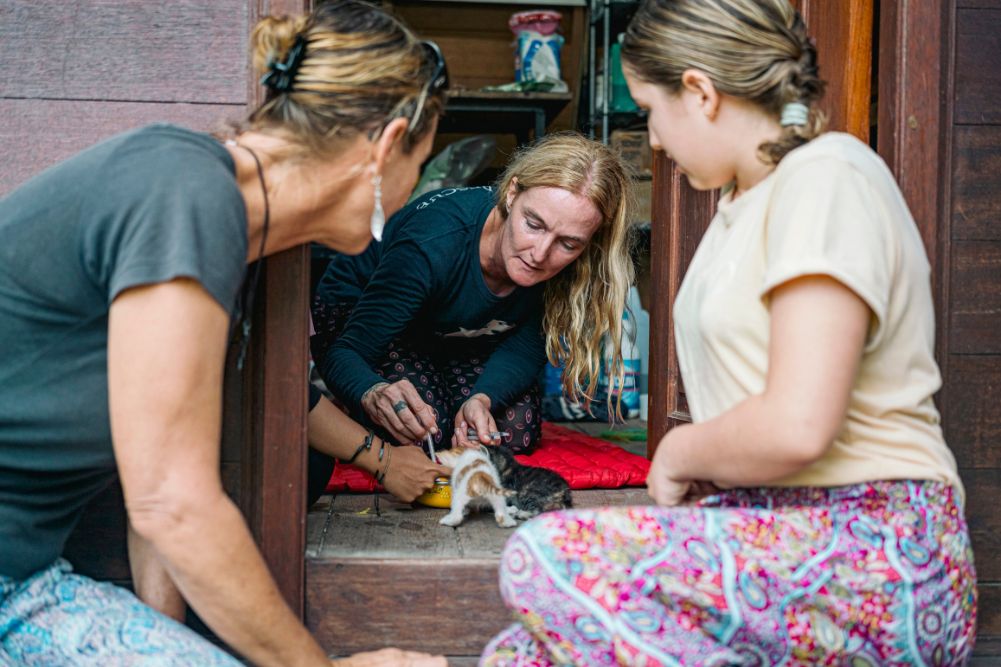Saving Elephants
They’re utterly gargantuan and they can be garrulous but, most of all, they’re glorious. Nothing quite beats the awe and wonder of a close encounter with an elephant, a creature whose sheer magnificence few animals can match. These intelligent, intensely social and sensitive creatures combine vast size with intuition, gentleness and a palpable display of caring and compassion for their fellow pachyderms.
Yet their survival is in jeopardy. Elephants need room to roam and, as the battle for space on a planet with rapidly diminishing tracts of forest intensifies, the plight of the elephant has become emblematic of global environmental challenges that pit humans against animals. Securing a positive future for elephants is synonymous with the quest to safeguard the biodiversity of the earth itself.
Closest to home are Asian elephants, which are smaller than their African counterparts and have smaller ears and smoother, darker skin. Fortunately, conservation efforts have gained momentum and the Southeast Asian region abounds with opportunities to appreciate these extraordinary animals at close range and to actively contribute to their welfare. To spend time with elephants is a privilege. It is deeply humbling to bond with a species that has a great potential for ferocity yet is characterised by its gentleness, strong kinship bonds and complex means of communicating.
In ancient Oriental kingdoms, the elephant’s colossal strength built cities and defended empires, but today the relationship between humans and elephants is more complex. They are often exalted, as is the case with temple elephants, and sometimes associated with divinity. Asian folklore tells of prized white elephants believed to be symbols of a king’s might and regarded as a smile from the gods. Within the Hindu pantheon, Ayravana is the war elephant of the god Indra, and Ganesha, the elephant-headed son of Shiva, is a harbinger of prosperity and wisdom. But modern working elephants are often exploited for their labour and wild elephants are poached for their tusks and occasionally for their meat.
Powerful yet precarious
As the once mighty forests of Asia are levelled for agriculture, timber and settlement, the Asian elephant is left with no place to go. It’s estimated that numbers of wild elephants have dwindled from around 100,000 in 1900 to between 25,000 and 33,000 today, a figure that has placed them on the endangered species list. With economic growth gathering pace, further declines are almost inevitable.
Elephant herds often number in their hundreds and typically follow monsoon-defined migration routes. What was once an easy journey from feeding place to feeding place has now become a hazardous obstacle course as crops and towns pop up along traditional routes, leaving only fragmented patches of forest to support the elephants. When hungry elephants, who can eat up to 200kg of food a day and can each consume up to 200 litres of water, encounter lush plantations of their favorite foods such as bananas and sugar cane, entire harvests and villagers’ livelihoods can be destroyed in a single night.
So far, elephant fences and “scaring squads”, which drive raiding elephants back into the jungle, are having some effect but these human–elephant conflicts can often result in the deaths of villagers and elephants. Poaching also continues to be a threat, despite international bans on ivory. Ironically, the environmental benefits of ceasing logging and the adoption of more modern farming methods have resulted in thousands of unemployed elephants reduced to begging on the streets or being sold off as tourist attractions.
Wild ways
Elephants are highly intelligent creatures (in Thailand, for instance, they have been taught to paint and to take part in musical performances) and engage in vivid displays of complex emotions. They are profoundly social animals that form lifelong attachments. Young elephants are raised within an extended, hierarchical network of doting female carers, including the birth mother, grandmothers, aunts and friends. If harm comes to a member of an elephant group, or if a member of the group has been wronged by another, all the other elephants respond to the situation.
Age counts for a lot in elephant society. Elder members of the herd are charged with ensuring the group’s safety and pass on information about migration routes, water holes and feeding grounds, earning in the process the respect of younger herd members. When an elephant dies, family members engage in intense mourning rituals. They hold vigils over the body for a time, the carcass is carefully covered with earth and brush, and the resting place is revisited for years afterward. They caress the bones with their trunks, even taking turns to rub their trunks along the teeth of the skull’s lower jaw, the way living elephants do in greeting each other.
An elephant call may be one of the most startling and majestic sounds you’ll ever hear in the wind, but, for the most part, elephants communicate in ways that are subtle and sensitive. Their complex language, said to number more than 70 types of calls, produces social cohesion, reinforces bonds between relatives and friends, reconciles differences, forms coalitions against aggressors, coordinates group movement and keeps elephants in contact over long distances.
In close proximity, messages are conveyed via vocalisations, from low-frequency rumbles to higher-pitched screams and trumpets, along with a variety of visual signals, from waving their trunks to the angle of the head, body, feet and tail. When communicating over long distances — say, to pass along news about imminent threats, a sudden change of plans or, of the utmost importance to elephants, the death of a community member — they use subsonic vibrations that can be felt many kilometres away by sensors in the padding of their soft feet.
Another form of elephant communication believed to reinforce group bonding and protective instincts — and one that’s particularly magical to watch — is the way elephants constantly touch each other with their trunks. Decision-making is usually a democratic affair. However, in times of crisis, discussion gives way to the wisdom of the matriarch. The use of force or fear is not the matriarch’s way, though. She is a leader because the rest of the family trusts her to do the best for them and over time she has earned their respect.
Many researchers have also emphasised what great team players elephants are, demonstrating good leadership, good communication, clear roles, a spirit of cooperation and consensus building, respect for one another and skill at reconciliation.
Spending quality time with elephants is an experience not easily forgotten. Happily, enthusiastic conservation efforts are underway and there is a growing number of opportunities to appreciate and interact with these magnificent creatures and contribute towards their sustainability.
Elephant encounters
The Thai government set up the Thai Elephant Conservation Centre (TECC) in response to the number of elephants left without work when commercial logging was banned. The aim was to protect domestic and wild elephants as well as the communities that made a living from them. The Anantara Resort Golden Triangle forms part of this project and offers a range of interactive activities for tourists to enjoy. Chief among these is learning the skills of a mahout, the name for a keeper or driver of an elephant.
As I trek through bamboo forests and rice paddies I learn the delicate art of not only mounting an elephant but guiding it towards a local water hole where, together, we take a dip in the river and I reward my charge with a massage and scrub. Back at camp, I play a game of soccer with a gorgeous, waist-high baby elephant who loves to come up, lean on me, then take my hand in her trunk and lead me around. In the evening, we humans dine in the jungle while elephants munch on bananas nearby and call out to each other.
Anantara Resort Golden Triangle is five-star accommodation with a serene atmosphere, punctuated by ever–evocative elephant calls that we can hear as we sip our bracing morning coffee on the balcony daybed, while devouring the buffet breakfasts in the open-air dining area and, best of all, while savouring a spa experience.
In Sri Lanka, what is really special is the opportunity to see wild Asian elephants simply being, well, wild Asian elephants. You can’t go far in Sri Lanka without seeing them lumbering along the side of the road, gleefully relishing their dinner of freshly cut palm leaves, even weaving through the traffic in major cities, as happens often in Kandy. These elephants, however, lead lives constrained by chains and mahouts, unlike the wild herds that move, as they have for centuries, from watering hole to watering hole, making short work of elephant fences with one swift stroke of a tree branch.
In the savannah that forms Sri Lanka’s midriff, one of Asia’s largest movements of wildlife takes place each year from June to September. This is when herds of wild Asian elephants make for Minneriya National Park where, come evening, they emerge from the forest to drink, bathe and graze at the receded shores of ancient waterways. Remarkably, ours was the lone jeep to witness this somewhat surreal gathering of giants.
Wobbly babies whose ears almost outsize their bodies, play hide and seek and rumble amid protective circles of mothers and sisters. Young males, who brandish just a hint of tusk, saunter gingerly from group to group, proffer a tentative trunk in greeting, then test their mettle against their peers. A gangly teenager pauses to gobble grassy shoots, then sprints to catch up. Adult males, not welcome in the herd, loiter on the fringe of the forests, sometimes eyeing vehicles with portent. Marvelling at the sight of these wonderful animals, it’s hard to imagine a more memorable way to soak up a sunset.
Up close and personal
Want to boast of your own elephant encounter? Try these places:
- Elephant Nature Park, near Chaing Mai, Thailand: www.thaifocus.com/elephant
- yutthaya Elephant Camp: www.ayutthayaelephantcamp.com
- North of Surin, where the annual Elephant Round Up takes place, are the villages of Taklang and Gapoe, home to the Suay people. These people speak a unique language, having migrated from Southern Cambodia, and are revered for their elephant knowledge and handling skills that are considered an almost spiritual communication. For further information, visit Tourism Authority of Thailand: www.tourismthailand.org
- The Mahout Club, in conjunction with the Deer Park Hotel, runs a variety of very informative wildlife explorations in Sri Lanka: www.banyantree.com
- Sri Lankan parks, such as the beautiful and geographically varied Yala National Park, Udawalawe Sanctuary, Lahogalla National Park offer elephant experiences.
- To interact with elephants and contribute to a worthy animal charity, try Millennium Elephant Foundation, near Kandy, Sri Lanka: www.eureka.lk/elefound
Mother knows best
Scientists discover why it is important for herds to have old, experienced females as their leader
Elephants live in a social hierarchy dominated by older females. Females travel in long-lasting social units of about half a dozen adult females and their offspring, led by a single older female — the matriarch. Males don’t maintain long-term social bonds, remaining in the unit only into their teens. They then live out their lives in loose bachelor groups or wander on their own.
To test the importance of the age of the female leader of the individual units, researchers from the University of Sussex, the Institute of Zoology in London and the Amboseli Elephant Research Project in Kenya used high-powered hi-fi equipment to play back the sounds of elephant calls. Those from complete elephant strangers prompted the mothers to cluster around their young defensively, while familiar calls were ignored. The units led by the oldest matriarchs, those with the most experience, were best able to distinguish between friends and those that might present problems by harassing calves or starting disputes.
If these key individuals cannot immediately distinguish between potential threats, their families may spend too much time being defensive and not enough time reproducing. In fact, the scientists found the age of the matriarch to be a significant predictor of the number of calves produced by the family per female reproductive year.
These findings have important implications for conservation of elephants because older, larger animals are more likely to be targets for hunters and poachers, and killing these individuals could weaken entire family units for years.
Source: The World Conservation Union







